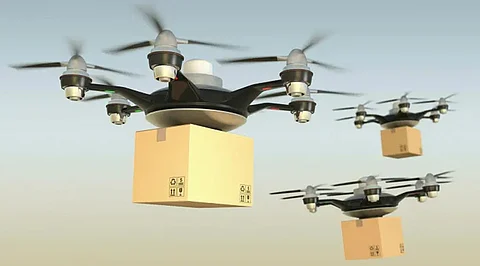
- Insights
- Cryptocurrencies
- Stocks
- White Papers
- Industry
- Geography
- Insights
- Cryptocurrencies
- Stocks
- White Papers
- Industry
- Geography


The global drone market's revenue was worth $18.28 billion in 2020, and it's projected to skyrocket to $40.90 billion by 2027. This growth is largely due to the increasing number of product offerings in the market. DJI drone models, for instance, recently incorporated assessing and mapping features, which can prove highly useful for many industries. During the pandemic, drones also served various critical functions.
As we mentioned in a previous article, Shenzhen-based company MicroMultiCopter deployed over 100 drones to broadcast information across a large area, while Japan-based commercial drone service company Terra Donne operated drone deliveries for medical supplies. Because these drones are immune to infection, drone products helped respond to mobility challenges. It's likely that commercial drones will be further integrated into daily use to prevent outbreaks moving forward. Here's how:
Amy Webb, the founder of Future Today Institute, has suggested that we're entering a Bioinformation Age in human history. Rather than focusing on privacy and personal choice, new social, government, and economic structures now require our data to operate. And we have seen how drones — equipped with object- and face-recognition, audio analytics, and motion detection features — are powerful tools, in terms of visualizing expansive areas and identifying people, particularly in search and rescue missions.
In the future, more countries will utilize drone capabilities to scan dense urban areas and broadcast messages through drone loudspeakers. Aside from social distancing surveillance, drones can allow governments to issue instructions or provide information to minimize physical contact. With better audio quality than a microphone, they can increase public awareness towards social distancing measures for even people without communication devices.
Modern drones are already designed to map and monitor areas overhead. Case in point, the drone cameras on Adorama, like Draganfly's Innovations Rededge MX Mapping Camera System, feature multispectral sensors for data collection. Primarily, this type of drone is used for agricultural and vegetation monitoring technology, and high-end agricultural drones can even be equipped with spraying technology to water crops or spray them with pesticides.
Governments experimenting with efficient ways to disinfect public spaces may apply the same technology for indoor microdrones, which can be deployed with disinfectants. The speed and area covered by drones would be unparalleled for disease control. However, this method should still be carefully studied; otherwise, there is a potential for drone-based fumigation to damage structures, increase pollution, or cause public health problems.
With the need to limit exposure and remain at home, drone package deliveries can help prevent package and food delivery systems from becoming a vector of transmission. Drones can be modified with a payload drop mechanism, for a contact-free way to hand off critical supplies up to 6 kilograms. Aside from delivering food, medicine, and PPEs, drones have been utilized to collect patient samples. Rwanda even used drones to reduce waste in their blood supply chain.
We can expect to see more countries using drone delivery for consumer products as well. WeForum reports that Alphabet's Wing subsidiary doubled drone deployment rates to access more customers during the pandemic, providing a lifeline to local businesses; Wing's partners have claimed a 50% increase in sales of certain goods. Of course, this will depend on the overall business model, as drone deliveries may not be suitable in areas where consumer demand is low.
